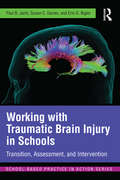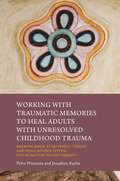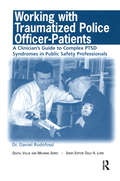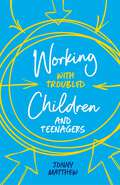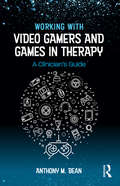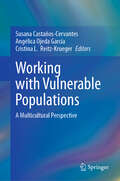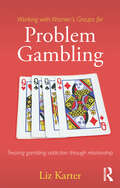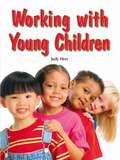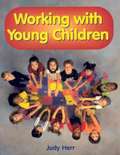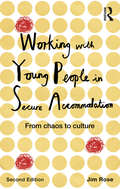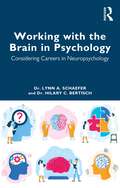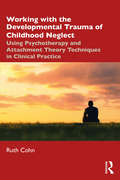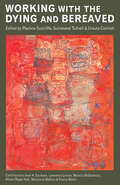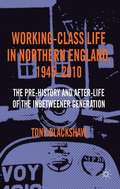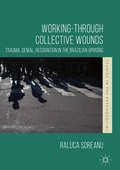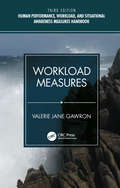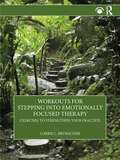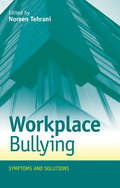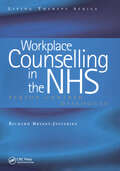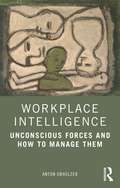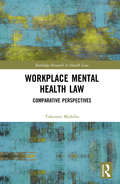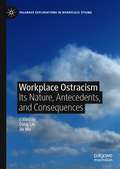- Table View
- List View
Working with Traumatic Brain Injury in Schools: Transition, Assessment, and Intervention (School-Based Practice in Action)
by Erin D. Bigler Paul B. Jantz Susan C. DaviesEvery day, children and adolescents worldwide return to the educational setting having sustained a traumatic brain injury (TBI). The possible negative consequences of TBI range from mild to severe and include neurological, cognitive, emotional, social, and behavioral difficulties. Within the school setting, the negative effects of TBI tend to persist or worsen over time, often resulting in academic and social difficulties that require formal and informal educational assistance and support. School psychologists and other educational professionals are well-positioned to help ensure students with TBI receive this assistance and support. Working with Traumatic Brain Injury in Schools is a comprehensive practitioner-oriented guide to effective school-based services for students who have experienced a TBI. It is primarily written for school-based professionals who have limited or no neurological or neuropsychological training; however, it contains educational information that is useful to professionals with extensive knowledge in neurology and/or neuropsychology. This book is also written for parents and guardians of students with TBI because of their integral role in the transition, school-based assessment, and school-based intervention processes. Chapter topics include: basic brain anatomy and physiology; head injury and severity level classifications; biomechanics of injury; injury recovery and rehabilitation; neurological, cognitive, emotional, behavioral, social, and academic consequences; understanding community-based assessment findings; a framework for school-based assessment (TBI-SNNAP); school-based psychoeducational report writing, and school-based interventions; monitoring pharmacological interventions; and prevention. An accompanying website includes handouts, sample reports, and training templates to assist professionals in recognizing and responding to students with TBI.
Working with Traumatic Memories to Heal Adults with Unresolved Childhood Trauma: Neuroscience, Attachment Theory and Pesso Boyden System Psychomotor Psychotherapy
by Jonathan Baylin Petra WinnetteWhat potential does psychotherapy have for mediating the impact of childhood developmental trauma on adult life? Combining knowledge from trauma-focused work, understandings of the developmental brain and the neurodynamics of psychotherapy, the authors explain how good care and poor care in childhood influence adulthood. They provide scientific background to deepen understanding of childhood developmental trauma. They introduce principles of therapeutic change and how and why mind-body and brain-based approaches are so effective in the treatment of developmental trauma. The book focuses in particular on Pesso Boyden System Psychotherapy (PBSP) which uniquely combines and integrates key processes of mind-body work that can facilitate positive change in adult survivors of childhood maltreatment. Through client stories Petra Winnette and Jonathan Baylin describe the clinical application of PBSP and the underlying neuropsychological concepts upon which it is based. Working with Traumatic Memories to Heal Adults with Unresolved Childhood Trauma has applications relevant to psychotherapists, psychologists and psychiatrists working with clients who have experienced trauma.
Working with Traumatized Police-Officer Patients: A Clinician's Guide to Complex PTSD Syndromes in Public Safety Professionals (Death, Value and Meaning Series)
by Daniel Rudofossi Dale A. Lund Alan W. BennerAn insider perspective from a 'cop doc on the job,' this book is the first of its kind written in response to a need for a specialized guide for clinicians that operationally defines and responsibly treats what Dan Rudofossi terms Police and Public Safety Complex PTSD. In reading this book, you are led through an understanding of how to work with police officers who experience cumulative loss in trauma. "Doc Dan" initiates you into an original cultural competence of how and why his theory works in practice. You will leave the journey with a practical sense of how the ecological context and ethological motivation are part of the psychological presentation of almost all officers suffering from complex trauma and loss.This guide is crucial reading, original in its breadth and scope of perspective on how to intervene with the traumatized officer. Toward that end, Rudofossi presents his Eco-Ethological Existential Analysis of Police and Public Safety Complex Post Traumatic Stress Disorder. Emotive, affective, cognitive, behavioral, and existential ranges of expression of trauma are vast, diverse, and often intense in police officers. This book delivers applied theory with clinical examples, including practical interventions for the clinician and handouts for the officer-patient. The clinician will be assisted in encountering officers' existential suffering from the edge of despair to the precipice of meaning. The guide is at once stimulating, exciting, and very serious in its potential for clinical interventions.
Working with Troubled Children and Teenagers
by Jonny MatthewWorking with Troubled Children and Teenagers is an easy to understand guide packed with wisdom for anyone working with or caring for troubled children and teens. Author Jonny Matthew has decades of experience of working with young people, and offers simple but hard-won advice about how to earn the trust and respect of even the most challenging young people. It all starts with you, the adult, adopting a position of respect and patience. It's only then that children and young people will start to respond. From this starting point, Jonny provides a wealth of practical advice across a wide range of challenging topics - from the use of touch and understanding boundaries through to repairing relationships when things break down. Jonny uses case examples and stories throughout to bring his advice to life. This inspiring book is essential reading for any adult invested in improving the lives of troubled children, including youth workers, social workers, foster carers and child counsellors.
Working with Video Gamers and Games in Therapy: A Clinician's Guide
by Anthony M. BeanWorking with Video Gamers and Games in Therapy moves beyond stereotypes about video game addiction and violence to consider the role that games play in psychological experiences and mental health. Chapters examine the factors that compel individual gamers to select and identify with particular games and characters, as well as the different play styles, genres, and archetypes common in video games. For clinicians looking to understand their clients’ relationships with video games or to use games as a therapeutic resource in their own practice, this is a thoughtful, comprehensive, and timely resource.
Working with Vulnerable Populations: A Multicultural Perspective
by Susana Castaños-Cervantes Angélica Ojeda García Cristina L. Reitz-KruegerThis book explores vulnerability in many forms and among diverse understudied vulnerable populations worldwide from different perspectives, particularly from non-western contexts. It examines characteristics and profiles of vulnerable populations, intervention strategies, and recommendations for public policy actions in developing and emerging countries. As the world becomes increasingly connected and localities become more diverse, researchers and practitioners working to ameliorate human suffering cannot rely on one-size-fits-all solutions, especially when it comes to the most vulnerable members of society. The book argues the need for interdisciplinary research and action, and it challenges popular discourse on vulnerable groups and intervention strategies in Western societies and developed countries. In particular, it includes a Latin American perspective seldom considered in research about vulnerability worldwide. With interdisciplinary contributors from four continents, working in diverse fields such as social psychology, pedagogy, community psychology, medicine, sociology, clinical psychology, anthropology, and social work, this edited collection brings together theoretical and applied research evidence on three vulnerable population categories: physical vulnerability, psychological vulnerability, and social vulnerability. The book not only presents exhaustive solutions to any of the problems discussed therein, but it also offers examples of the considerations that should be afforded when working with groups who have unique vulnerabilities. Among the topics covered in the chapters: Poor Doctor-Patient Communication: How Social Vulnerability Turns into Physical Vulnerability Art Therapy: Focus to Decrease Vulnerability Condition and Increase Sense of Community Pedagogical Guidelines for Vulnerability in Postmodernity Working with Vulnerable Populations: Final Reflections and Implications Working with Vulnerable Populations: A Multicultural Perspective presents case studies, original research, and literature reviews that would engage students and professionals interested in social work, psychology, community organizing, public health, allied health professions, and other helping professions. Readers will gain insight into how work being conducted in various localities speaks to the challenges they may face in their own work or research. By exploring the unique issues facing vulnerable populations around the globe, we can apply those same considerations in our own communities.
Working with Women's Groups for Problem Gambling: Treating gambling addiction through relationship
by Liz KarterWhy do so many women with gambling addiction relapse? Lifelong recovery requires much more than to just stop gambling. Women’s groups provide long-term benefits and support and have proven to be highly successful in promoting recovery from gambling addiction. By following the story of a real women’s group for problem gambling over the course of a year, Liz Karter explains how, for women, both the cause of and the cure for gambling addiction lies in relationship. Karter shows clearly how learning to face and cope with real life situations and relationships is essential to maintain recovery. She shares the themes which run through each women’s group, such as fear of trusting others, and the guilt, shame and risk associated with being truly seen and heard. Women’s Groups for Problem Gambling shows that with a combination of specialist intervention, women’s group support, courage and compassion, women can learn to stop running from their addiction and instead find joy and support in building relationships and communities. This highly accessible book provides a unique opportunity to gain a very personal insight into the group process, both for therapists and clinicians and for women wishing to better understand their addiction.
Working with Young Children
by Judy HerrThe book helps students prepare for a career in early childhood education. It teaches practical techniques to guide children through a variety of daily experiences in safe, educational ways. It also includes an overview of physical, intellectual, social, and emotional characteristics of young children.
Working with Young Children
by Judy HerrWorking with Young Children focuses on the application of child development principles to the care of children in group settings. Introduce your students to the fast-growing field of child care services, and help them learn the necessary skills. This popular text features an inviting, colorful format and up-to-date topics. -- Topics include the CDA credential; guidance principles; water play, sand play, and block building experiences; new social studies topics; and more on-the-job application process. -- Helps students develop effective skills for guiding children and for keeping them safe and healthy. -- Provides instruction for setting up a developmentally-appropriate environment. -- Covers planning and implementing curriculum that will meet children's needs and hold their interest. -- Includes hundreds of full-color photos taken in actual child care settings.
Working with Young People in Secure Accommodation: From chaos to culture
by Jim RoseThe detention of children and young people as a response to delinquent and antisocial behaviour remains a topical and controversial issue. In this new edition of Working with Young People in Secure Accommodation, Jim Rose provides an historical perspective on the topic of young people in custody and discusses the changes that have taken place in youth justice and the secure estate over recent years. Rose introduces new material and has updated the original content in order to reflect changes in policy and practice. New areas covered include a consideration of the issues arising for children and families who are detained while issues of immigration and removal are being determined and the detention of children in police custody. Using a framework of ideas and theories to support staff thinking, the central chapters explore in detail the dynamics that emerge when the daily work of staff requires them to engage with vulnerable young people in the intense conditions of a locked environment. The relationships between staff and young people are shown as critical for the achievement of positive outcomes. Taking a unique look at the issue of detention and its impact on young people, this highly topical book will be invaluable reading for practitioners, academics, policy makers and senior managers as well as students of social work, youth justice and education.
Working with the Brain in Psychology: Considering Careers in Neuropsychology
by Lynn A. Schaefer Hilary C. BertischWorking with the Brain in Psychology: Considering Careers in Neuropsychology seeks to assist students in their career exploration, by introducing them early, in the contemplative stage of career planning, to the fascinating speciality of psychology known as neuropsychology. The text spends considerable time differentiating neuropsychology from alternative career paths, and provides personal accounts, contributions from neuropsychologists in various settings, and case examples of different patient populations to illustrate what it is like to train to become and work as a neuropsychologist. This text begins by describing what neuropsychology is, how it is situated within psychology, and for whom it could be a good fit. Suggestions are provided about how to engage in self-assessment in order to help choose a career. It goes on to review over a dozen similar and overlapping careers to illustrate how neuropsychology stands out. Quotes by professional neuropsychologists bring to life what "a day in the life" looks like in different settings, and the kinds of populations with whom neuropsychologists work are illustrated with case examples. This book then outlines how one becomes a neuropsychologist, including how to re-specialize from a different field. It also gives an honest appraisal of potential challenges that come with this career, and ends with anticipated future directions in the profession to look forward to. This book will be useful primarily for psychology-minded undergraduates and college graduates thinking of going on to graduate school for psychology, as well as for high school students interested in the brain and psychology. This book is further aimed at those considering a change of career from a related field into neuropsychology, as well as the guidance counselors and college career centers that assist with career planning.
Working with the Developmental Trauma of Childhood Neglect: Using Psychotherapy and Attachment Theory Techniques in Clinical Practice
by Ruth CohnThis book provides psychotherapists with a multidimensional view of childhood neglect and a practical roadmap for facilitating survivors’ healing. Working from a strong base in attachment theory, esteemed clinician Ruth Cohn explores ways therapists can recognize the signs of childhood neglect, provides recommendations for understanding lasting effects that can persist into adulthood, and lays out strategies for helping clients maximize therapeutic outcomes. Along with extensive clinical material, chapters introduce skills that therapists can develop and hone, such as the ability to recognize and discern non-verbal attempts at communication. They also provide an array of resources and evidence-based treatment modalities that therapists can use in session. Working with the Developmental Trauma of Childhood Neglect is an essential book for any mental health professional working with survivors of childhood trauma.
Working with the Dying and Bereaved: Systemic Approaches to Therapeutic Work
by Ursula Cornish Pauline Sutcliffe Guinevere TufnellFirst published in 1998. Working with the Dying and Bereaved illustrates how therapists can use a systemic approach to help families facing death and bereavement. This approach considers the individual in a broader, more holistic concept than traditional theories. This book provides a broad theoretical framework and practical strategies for systemic therapeutic work. Each chapter demonstrates how each approach has been applied by the therapist to work within a particular model, carefully outlining the particular technique used.
Working-Class Life in Northern England, 1945–2010
by Tony BlackshawTaking a fresh look the history of northern working-class life in the second half of the twentieth century, this book turns to the concept of generation and generational change. Using life history research conducted with the intermediary generation that preceded the Boomers, the author explores Zygmunt Bauman's bold vision of modern historical change as the shift from solid modernity to liquid modernity. Blackshaw argues that this shift was marked by a 'pure event' that led to the onset of the twentieth-century Interregnum in which 'a great variety of interesting phenomena did appear', but most notably a revolution in everyday life that radically altered the reigning structures of time and order.
Working-through Collective Wounds: Trauma, Denial, Recognition In The Brazilian Uprising (Studies in the Psychosocial)
by Raluca SoreanuWorking-through Collective Wounds discusses how collectives mourn and create symbols. It challenges ideas of the irrational and destructive crowd, and examines how complicated scenes of working-through traumas take place in the streets and squares of cities, in times of protest. Drawing on insights from the trauma theory of psychoanalyst Sándor Ferenczi and his idea of the ‘confusion of tongues’, the book engages the confusions between different registers of the social that entrap people in the scene of trauma and bind them in alienation and submission. Raluca Soreanu proposes a trauma theory and a theory of recognition that start from a psychoanalytic understanding of fragmented psyches and trace the social life of psychic fragments. The book builds on psychosocial vignettes from the Brazilian uprising of 2013. It will be of great interest to psychoanalysts interested in collective phenomena, psychosocial studies scholars and social theorists working on theories of recognition and theories of trauma.
Workload Measures
by Valerie Jane GawronThis book was developed to help researchers and practitioners select measures to be used in the evaluation of human/machine systems. The book includes definitions of human workload and a review of measures. Each measure is described, along with its strengths and limitations, data requirements, threshold values, and sources of further information. To make this reference easier to use, extensive author and subject indices are provided. Features Offers readily accessible information on workload measures Presents general description of the measure Covers data collection, reduction, and analysis requirements Details the strengths and limitations or restrictions of each measure, including proprietary rights or restrictions Provides validity and reliability data as available
Workout mit Baby: Was gut tut und fit hält
by Josef Kessler Constanze Bast-Kessler Jana KriegerFit nach der Geburt und ein zufriedenes Baby - das wünschen sich Mütter, Väter und Großeltern. Keine Zeit für das Fitnessstudio, keine Geräte zuhause? Das Kind will geknuddelt, bewegt oder beruhigt werden? Lassen Sie sich ein auf Übungen, mit denen Sie selbst mobil und stark bleiben und die Sie zusammen mit dem Baby ganz einfach durchführen können.Das Buch bietet mithilfe von Illustrationen Anleitungen für kurze Trainingseinheiten, die Sie spielerisch in den Alltag einstreuen können. Inklusive Aufwärmübungen, Muskeltraining und Dehnungen. Nebenbei erklären der Neuropsychologe und die Psychologin, wie sich das Kind nach der Geburt geistig und körperlich entwickelt und wie Sie fit bleiben, gemeinsam mit dem Baby viel Spaß haben und gleichzeitig dessen Motorik und Sinne ansprechen.
Workouts for Stepping into Emotionally Focused Therapy: Exercises to Strengthen Your Practice
by Lorrie L. BrubacherWorkouts for Stepping into Emotionally Focused Therapy is a companion to Stepping into Emotionally Focused Therapy: Key Ingredients of Change (2nd ed.). Inspired by Deliberate Practice, it is filled with exercises called workouts first with couples (EFCT), followed by a series of workouts in that same skill or move with individuals (EFIT).The workouts are more than skill-drills. They are clear, tangible ways for the reader-practitioner to become emotionally engaged within self and in attunement with each client scenario and to strengthen their EFT muscles with the practice of each of these EFT ingredients of change. Part 1 includes workouts of ten micro-skills across a wide range of client scenarios, including diversity of racial, ethnic, gender, sexual orientation, religious, neurodiversity, and other contextual diversity. Workouts with the five moves of the EFT Tango, from beginning of therapy to the completion of Stage 2 change, first with a couple and then with an individual, make up Part 2. The reader-practitioner has opportunity in Part 3 to apply the macro-intervention to Stages 1 and 2 change in their own lives, to explore barriers to following and deepening emotions, and to utilize a series of antidotes for typical EFT therapist challenges and goal-setting.Containing practical handles for the new clinician or graduate student wanting to integrate EFT into their practice, it is also stimulating and relevant for seasoned therapists and counselors seeking to sharpen EFT skills and develop confidence in the model with both couples and individuals.
Workplace Bullying: Symptoms and Solutions
by Noreen TehraniIs bullying really that bad? Why do some people just watch it happening? How do you know if it is bullying or strong management? What kind of leaders are able to create positive working environments? The effects of bullying on organisations and individuals can be devastating and can adversely affect both the workers themselves and the productivity of the organisation that they work for. This book explores the impact of bullying from the perspective of both the employee and the organisation in which they work. In addition to describing the negative outcome of bullying, Workplace Bullying also looks at ways to promote resilience and the opportunity for growth and learning to take place. Divided into four sections, this book covers: the impact and symptoms of workplace bullying individual interventions organisational interventions underlying causes and future considerations. Workplace Bullying is essential reading for anyone with responsibility to help and support workers involved in bullying as a victim, supporter, or investigator. It offers organisations a chance to create an environment that will not only build a more resilient workforce, providing appropriate and effective interventions, but also provides solutions that will lead to the possibility of individual and organisational growth and development.
Workplace Counselling in the NHS: Person-Centred Dialogues (Living Therapies Series)
by Richard Bryant-JefferiesThis book has been written specifically to meet the needs of counsellors and trainers working with the National Health Service. It will also provide useful insights for doctors, nurses, and managers within the healthcare sector. The book covers topics such as, difference and diversity, colour, language barriers, oppressed nurses, stressed managers, changes in the NHS, exhaustion and late cancellations. Adopting the unique approach of the Living Therapy series, this book uses fictitious dialogues to enable the reader to directly experience the therapeutic process, providing real insight into the experience of workplace counselling in the NHS and also in other work settings.
Workplace Disaster Preparedness, Response, and Management
by Christina Thompson R. Paul Maiden Rich PaulRespond quickly and effectively to workplace traumaFor years, employee assistance programs have been providing critical incidence stress management services to employees who have been involved in, or witness to, workplace fatalities and accidents that are likely to traumatize workers and affect quality of work and increase sick leave and health claims. Workplace Disaster Preparedness, Response, and Management presents successful strategies for rapid response to episodes of workplace violence, natural disasters, and acts of terrorism that have become all-too-common occurrences in the workplace. Workplace Disaster Preparedness, Response, and Management is a must read for professionals in the business of providing crisis response services and for employers responsible for planning and coordinating organizational responses to disasters. This unique book presents first-hand accounts from EAP program managers, Critical Incident Stress Management (CISM) professionals, and crisis managers on their trauma response techniques and from health professionals involved in the aftermath of Hurricane Katrina and the Sept. 11 attacks on the World Trade Centers and the Pentagon. Workplace Disaster Preparedness, Response, and Management examines: similar and dissimilar experiences of EAP professionals in responding to large scale traumatic events using military models in trauma response managing trauma in the South African mining industry trauma response techniques in high risk work settings compassion fatigue among professional helpers how various types of industries handle critical incidents EAP responses to natural disasters repetitious violence in the workplace organizational crisis intervention and much moreWorkplace Disaster Preparedness, Response, and Management also includes Bern Beidel’s first-person account as EAP Director for the United States House of Representatives of the response to anthrax contamination in mailrooms and office buildings in the nation’s capital.
Workplace Intelligence: Unconscious Forces and How to Manage Them
by Anton ObholzerWorkplace Intelligence provides a range of insights into the unconscious processes at play in the workplace and an introduction to a balanced approach to organizations. The book explores key concepts, showing how our emotions and early experiences inform the roles we play at work, as well as how we react to other people. It encourages close observation and reflection and utilization of this knowledge for managing ourselves and others fruitfully. It also provides managers with the methods to intervene and tackle these issues, elaborating on topics from leadership and group dynamics to meetings and work-life balance. The book will be a fascinating read for those in leadership roles, organizational consultants, executive coaches, students of occupational psychology, as well as anyone interested in understanding workplace dynamics in general.
Workplace Mental Health Law: Comparative Perspectives (Routledge Research in Health Law)
by Takenori MishibaThis book provides a systematic and interdisciplinary study of occupational mental health legislation in seven countries. The work presents a study of the laws, policies, and legal interpretations to help prevent mental health problems from occurring in the workplace and appropriately address problems once they do occur. With a view to improving provision in Japan, the author examines the legal issues relating to workplace mental health and stress in the USA, UK, Denmark, the Netherlands, France and Germany. In presenting a comparative discussion of mental health issues in the workplace, this book seeks to establish a minimum for legal rights and duties that contribute to prevention and not just compensation. With its detailed comparative and descriptive coverage of legal and related provisions in a range of countries, the book will be a valuable resource for academics, policy-makers and practitioners working in labour and employment law, social welfare, occupational health and human resource management.
Workplace Ostracism: Its Nature, Antecedents, and Consequences (Palgrave Explorations in Workplace Stigma)
by Cong Liu Jie MaWorkplace mistreatment is a burgeoning topic of interest, with the majority of workers having experienced it in some form. This book explores workplace ostracism and its negative effects on employee and organizational outcomes, such as employee attitudes, behaviors, and well-being. This edited volume defines workplace ostracism and examines how to differentiate ostracism from other type of workplace mistreatment, such as workplace incivility and interpersonal conflict. Among the questions it seeks to answer are: 1) what are the individual, relational, and contextual factors that influence employees’ workplace ostracism experiences; and 2) what constitutes ostracism in stigmatized populations, such as international students, immigrant workers, and older workers. Researchers in organizational behavior, I/O psychology, and the sociology of work will find this book to be a valuable resource.
